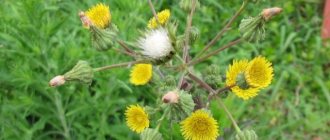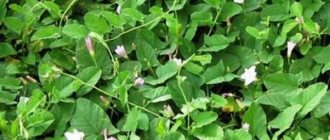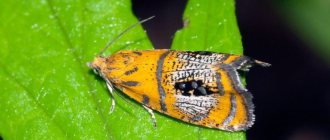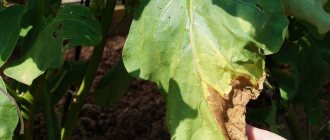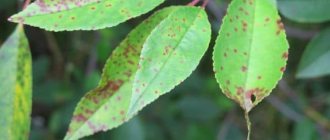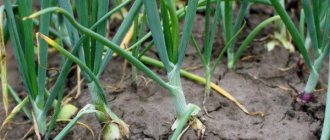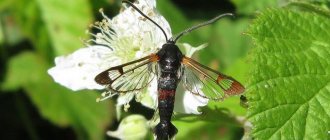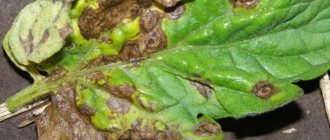The list of weeds that complicate the life of summer residents is very long. Among them there are some that are extremely difficult to get rid of. Today we will tell you how to get rid of field bindweed on your property - a cute-looking but incredibly insidious weed.
Why is field bindweed so dangerous?
Firstly, it absorbs moisture and nutrients from the soil, taking them away from cultivated plants. Bindweed especially “pulls” a lot of nitrate nitrogen from the soil, which it desperately needs. For this reason, plants growing in the neighborhood begin to experience a lack of nitrogen, which has an extremely negative effect on their growth and development, especially at the beginning of the growing season.
Secondly, bindweed is a climbing weed. It entwines everything it encounters on its way, including the stems of cultivated plants. This can lead to lodging and inhibit the growth of garden crops, which ultimately will negatively affect the harvest.
Field bindweed: plant description
Field bindweed (popular names - birch, field bindweed, bellflower, etc.) is a perennial plant of the Convolvulaceae family. It has a long climbing stem and branching rhizome. The bare thin stem of bindweed reaches a length of 1.5-3 m.
All along the stem there are small flowers - about 2 cm in diameter. In shape they resemble a bell (hence one of the popular names for bindweed) or a small gramophone. The color is most often white or pink. Flowering lasts several months, starting in April and ending in late autumn.
The rhizome is powerful. Vertical roots can go deep up to 3, and according to some data, up to 9 m. The main part of the root system is horizontal root shoots, which are located at a distance of 30-40 cm from the soil surface. They contain dormant buds, which, when the rhizome is damaged, immediately awaken, begin to grow and produce a new sprout. This is one of the ways to propagate field bindweed.
Small - just a few centimeters - parts of the rhizome are enough so that in the presence of heat and moisture they form new plants. This is one of the reasons bindweed is so difficult to remove from the site.
The second way to propagate the weed is by seeds. Each plant contains a large number of flowers, which in one season can form a total of up to 10 thousand seeds. The seeds are spread both by the wind and by animals that happily eat the weed.
Bindweed seeds remaining in the ground can lie at a depth without losing viability for up to five, and according to some sources, up to 50 years. Once favorable conditions occur, they will again give life to a new plant.
The danger of bindweed in the garden
Field bindweed is a herbaceous perennial plant from the family of the same name with an extensive root system that penetrates the soil layers to a depth of 2-3 meters. The flowers, painted white, soft purple or soft pink, are funnel-shaped. The flowering period lasts from May to August. This weed is widespread in European and Asian countries.
Despite its visual appeal, bindweed is dangerous in potato fields, vegetable gardens and summer cottages:
- promotes rapid drainage of the soil, drawing moisture from it due to a strong root system;
- long stems quickly wrap around cultivated plants, as a result of which they are deprived of light and nutrients;
- actively reproduces through seeds and root system;
- plays the role of a refuge for numerous insect pests;
- depletes the soil, slows down the growth of cultivated plants.
How to get rid of bindweed
Considering the incredible vitality of field bindweed, it is extremely difficult to get rid of it. This process may take more than one season. And only active and regular actions will help you remove bindweed from the site forever.
The most effective ways to combat birch:
Regular weeding
No matter how trivial it may sound, this simple agricultural technique can help you get rid of bindweed. However, when weeding you need to follow several rules:
- For the fight to be effective, you need to know several features of bindweed. After damage to the rhizome, as mentioned above, the weed immediately begins to grow a new shoot from a dormant bud. Initially, it uses the nutrients accumulated by the root to grow. The root, giving up its reserves, weakens and becomes depleted. When the sprout reaches the ground and the growth of green mass begins, the process of photosynthesis will begin. As a result, the production of nutrients will begin, the rhizome will replenish its spent reserves and return to normal. Therefore, our goal is to prevent the root from recovering. And to do this, you need to remove the sprouts that appear as soon as they hatch from the ground, preventing leaves from appearing.
- Removal of emerging plants should be carried out regularly. The root will be able to help the dormant buds germinate several more times, but eventually its strength will be so depleted that new shoots will stop appearing - the plant will die.
Sowing green manure
Another way to remove bindweed from the site is to sow green manure in the garden. You can use any green manure plants with a branched root system, such as rapeseed, mustard or fescue. It will be difficult for bindweed shoots to break through the dense carpet woven from their roots.
If you have free space, you can grow green manure throughout the season. In the spring, at the end of April - beginning of May, sow empty areas clogged with bindweed and mustard. Allow it to fully grow and form seeds. At the end of summer, mow the mustard. The fallen seeds will germinate and produce new shoots. In the fall, mow them again and embed them in the ground. Such manipulations will help to completely get rid of bindweed on the site in a few seasons.
If you count every piece of your garden and there is no free space, then instead of green manure you can plant corn or sunflowers. These plants have a very branched fibrous and powerful root system. It is unlikely that bindweed will be able to break through the soil penetrated by their roots.
Mulching material
Everyone knows that not a single plant can live without light. You can use this feature in the fight against bindweed. Starting in early spring, cover the beds with any black material, such as film or spunbond, to prevent the weed from germinating.
When planting many garden crops, you can also use black spunbond, as many summer residents do in their strawberry beds. In places where cultivated plants will be located, cut small holes and plant seedlings there. The amount of bindweed during such planting will be significantly less than in conventional beds.
Soil deoxidation
Field bindweed loves acidic soil. To make him feel uncomfortable on your site and leave your property, you need to reduce the acidity level of the soil. In what ways can this be done? We list the most popular materials that allow you to deoxidize the soil:
- lime - it is better to apply it in the fall, after harvesting, so as not to harm cultivated plants (0.3 kg per 1 sq.m);
- chalk - like lime, is added only in the autumn (0.4 kg per 1 sq.m);
- dolomite flour - it can be added to the soil not only in the fall, but also in the spring, while digging the soil (0.4 kg per 1 sq.m);
- ash is not only a good soil deoxidizer, but also an excellent natural fertilizer (1 kg per 1 sq.m.).
- How to deoxidize the soil on the site - useful tips for gardeners and gardeners
Acidic soil on a site can destroy many plants and negate all efforts to grow them. How to correct soil acidity in beds and gardens?
Herbicides
Chemicals should be used in the fight against bindweed only if all means have been exhausted, and it continues to invade new territories. But even strong herbicides will not help you deal with bindweed at once, so you will have to use them more than once.
To destroy field bindweed, it is better to use glyphosate herbicides, which, when they fall on the above-ground part of the plant, penetrate inside and move along the conductive paths to its root system. This is how the weed is gradually destroyed.
For the use of herbicides to be effective, do not carry out any work on the treated area for 3-4 weeks after application. If you accidentally touch a bindweed rhizome that has not yet died, the growth of dormant buds will begin, and the weed will continue to grow.
Field bindweed is sensitive to herbicides such as Bis-300, Miura, Lazurit and others.
Read the instructions carefully. Many herbicides can only be applied after harvest or in vacant areas. During the growth of garden crops, their use is prohibited.
Complete shading of the area
Orchid leaves: main diseases and methods of combating them
A simple and effective way to control weeds is to cover the area with materials that do not allow sunlight to pass through. However, it requires the investment of certain financial costs, as well as the presence of a large or unplanted vegetable garden.
What materials are suitable
The whole area or part of it is covered with black plastic film, cardboard, roofing felt, plywood or other materials that do not allow sunlight to pass through. In this state, the garden will last at least a season. Over the summer, the bindweed should die in this area, but do not forget about the seeds, the germination of which will last up to 3 years.
Which plants are suitable
Another option involves laying mulch in a thick layer to prevent bindweed from germinating. But, as practice has shown, this method leads to weakening of the weed, but not to its death. The same can be said about planting zucchini, pumpkins and other plants whose large leaves can shade the area. This option can only be used if the bindweed infestation is small.
Area shading procedure
Useful properties of bindweed
The malicious weed field bindweed is a folk healer recognized by many generations. All parts of the plant are used for medicinal purposes: roots, leaves, stems and flowers. They are dried, and then infusions, decoctions and tinctures are prepared from the raw materials, and added to medicinal preparations along with other herbs.
What diseases does bindweed help with? It has a choleretic and diuretic effect, heals wounds, is used as a laxative, improves intestinal function, strengthens the walls of blood vessels and reduces the risk of developing cardiovascular diseases.
Before using any herbal medicine, be sure to consult your doctor!
Getting rid of a weed like bindweed is not at all easy. Victory in this war will depend on your perseverance and determination.
Prevention
Competent preventive measures are designed to protect the summer cottage from the abundant spread of the weed.
To do this you need:
- Maintain an optimal level of soil acidity. It can be balanced by adding wood ash or lime.
- In the autumn, after harvesting, dig up the garden. The roots of weeds will end up on the surface and freeze during the winter.
- Repeated thorough digging of the soil should be done in early spring, before planting crops. At this stage, check for any remaining weed rhizomes and remove them.
- When the first shoots appear, remove them immediately.
By following all these rules, you can protect the area from the appearance of weeds in the future.
Natural farming fight against bindweed. About weed control
3912
Weeding beds from weeds is one of the main summer garden operations. Which the children and grandchildren of gardeners do not like. For some mysterious reason, they don't want to spend their weekends crawling between garden beds. In traditional farming, weed control is carried out using herbicides. These are pesticides that prevent plants from growing. Everything would be fine, but vegetables don’t grow from herbicides either. Many gardeners have experienced this in their dachas. They treated the beds or paths with herbicides and the weeds stopped growing. Then they planted vegetables, which for some reason didn’t grow much either. And the neighbors’ plants along the borders of their plots were not doing well. But poison is poison. It affects not only plants, but also animals and people. Herbicides are especially harmful to small and unborn children. In natural farming, weed control methods are different. The main method is mulching. Mulch creates shade, and with a lack of light, any plants grow poorly. On average, mulch reduces the number of weeds by five times. Dealing with the remaining ones is quite simple. You just need to pull the weed by the tops and it will easily come out of the soil. After all, as a result of mulching, the soil becomes loose. Stretched weeds should be left on top of the bed - they themselves become mulch.
The second way to control weeds is to sow green manure. Dense plantings of green manure plants suppress the development of weeds. And white mustard suppresses even unsuppressable sow thistle. But there are weeds with a deep root system. For example, bindweed. Its roots were found at a depth of more than ten meters. There is no need to be especially afraid of such plants. They take nutrition deeply and do not have a major negative impact on the development of vegetables. They fight them in the following way. These plants just need to be trimmed periodically to the soil level. They are deprived of the foliage they need for carbon nutrition. They urgently need to grow foliage, and they do this at the expense of the organic mass of the roots. At the same time, the root system of plants decreases. This happens after each tops trimming. Gradually the weeds die off.
How to deal with loaches in a potato field. General characteristics of the plant
The weed family is Convolvulaceae.
The stem is thin and curly, growing up to 2 meters in length. Inflorescences are white and pink. One loach can produce up to 9800 seeds. It can also be propagated by pieces of the root system. The shelf life of seeds is 50 years. Bindweed is a native of the Mediterranean. There it is used not only as an ornamental plant, but also for medicinal purposes. In the 18th century it became widespread in other parts of Eurasia. Due to its rapid adaptability to various environmental conditions and the difficulties associated with its breeding, bindweed is considered a weed. Most of all, bindweed harms grain crops. The main harm is that it wraps itself around nearby plants and “smothers” them in its embrace. The result is a sharp decrease in yield. We must not forget that it competes with crops for nutrients and is difficult to get rid of.
The vegetative capacity of this plant is maintained throughout the summer, so various parts of it end up in granaries, which requires additional cleaning work. Cases have been recorded of bindweed greens causing poisoning in horses.
Possessing powerful roots containing a huge amount of nutrients, this plant is not afraid of even the most severe drought. While the cultivated crops are dying from the heat, it does not lack moisture and prospers. The root system usually consists of one root, capable of penetrating the soil to a depth of more than 6 meters, and root shoots branching off from it at a depth of 30–40 centimeters.
From them green shoots grow, reaching 2 meters. The seeds can germinate at any warm time of the year. In the first year of life, the plant rarely blooms; its main purpose is to deposit nutritional reserves in the root system. It was noticed that it is much easier to fight annual loaches than perennial ones.

